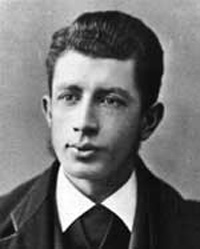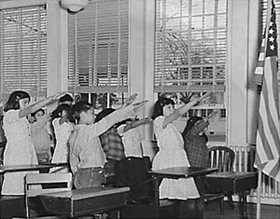|
Francis Bellamy
Answer
to Name
This Famous Person Game - October 2015
by Mike McLeod
|
 |
|
|
Although his name may not be known from sea to shining sea, Francis Bellamy’s words are repeated throughout the United States of America five days a week during most of the year. Do you know for what this obscure person is famous?
 Francis Julian Bellamy was born on May 18, 1855 in Monmouth, N.Y. His father was a Baptist minister, and Francis followed him is his education and career for a while. As a minister, Francis was a socialist Christian, and he believed that all public services and education should be nationalized, run by the government and provided to all. In the late 1800s and early 1900s, socialism came to be seen as a panacea for inequality. Bellamy’s share-the-wealth teachings over the pulpit eventually resulted in him being removed from his position. Francis Julian Bellamy was born on May 18, 1855 in Monmouth, N.Y. His father was a Baptist minister, and Francis followed him is his education and career for a while. As a minister, Francis was a socialist Christian, and he believed that all public services and education should be nationalized, run by the government and provided to all. In the late 1800s and early 1900s, socialism came to be seen as a panacea for inequality. Bellamy’s share-the-wealth teachings over the pulpit eventually resulted in him being removed from his position.
In 1891, Bellamy went to work for The Youth’s Companion, a weekly publication with an incredible circulation of 475,000 copies.1 The magazine also sold American flags to schools along with its magazine, and it campaigned to have a flag flying at each school to help unify a country that was not far in its history from the Civil War. With the 400th anniversary of the arrival of Christopher Columbus’ in America to be celebrated in 1894, the Columbian Exposition (later, the World’s Fair) was inaugurated in 1893, and Bellamy was tasked with writing a pledge of allegiance to the United State flag as part of the festivities.
There you have it. Francis Bellamy is the author of the Pledge of Allegiance. He wrote this in 1892:
“I pledge allegiance to my Flag and to the Republic for which it stands, one nation, indivisible, with liberty and justice for all.”
Under God was added to the pledge during the Eisenhower Administration in the 1950s.
Bellamy later wrote this of his feelings about the Pledge of Allegiance:
"It began as an intensive communing with salient points of our national history, from the Declaration of Independence onwards; with the makings of the Constitution... with the meaning of the Civil War; with the aspiration of the people... The true reason for allegiance to the Flag is the 'republic for which it stands'. ...And what does that last thing, the Republic mean? It is the concise political word for the Nation – the One Nation which the Civil War was fought to prove. To make that One Nation idea clear, we must specify that it is indivisible, as Webster and Lincoln used to repeat in their great speeches. And its future? Just here arose the temptation of the historic slogan of the French Revolution which meant so much to Jefferson and his friends, 'Liberty, equality, fraternity'. No, that would be too fanciful, too many thousands of years off in realization. But we as a nation do stand square on the doctrine of liberty and justice for all..."2
 Placing the hand over the heart during the Pledge of Allegiance has an interesting history. James B. Upham, an editor at The Youth’s Companion, first created the Bellamy salute (or flag salute) and directed that it start with a military salute with the hand pointing toward the eye and the elbow extended. Then, at the words “to my Flag,” the hand, palm down, was move gracefully forward and pointed toward the flag. This was used until 1942 when it was changed to the hand over the heart to avoid appearing to be a Nazi salute. Placing the hand over the heart during the Pledge of Allegiance has an interesting history. James B. Upham, an editor at The Youth’s Companion, first created the Bellamy salute (or flag salute) and directed that it start with a military salute with the hand pointing toward the eye and the elbow extended. Then, at the words “to my Flag,” the hand, palm down, was move gracefully forward and pointed toward the flag. This was used until 1942 when it was changed to the hand over the heart to avoid appearing to be a Nazi salute.
During WWII, the Nazis and Fascists began using the extended-hand salute of allegiance that has been attributed to the ancient Romans. I say “attributed” because there has not been found clear evidence of this salute being created or used by the Romans; however, similarities exist in sculpture and on coins. The Roman salute of the extended hand with fingers together is thought to have perhaps been created by the artist Jacques-Louis David in his 1784 painting The Oath of Horatii in which the salute is depicted.
Bellamy went on to work at several magazines, including the Ladies Home Journal for a while, and ad agencies. He retired to Florida in 1922, where he continued to work in advertising.3
Francis Bellamy died on August 28, 1931 in Tampa, Fla., and he is buried in Rome, N.Y.
Ted Carlton of Utah correctly identified Francis Bellamy.
---------------------------------------
1, 2, 3
The Pledge of Allegiance: A Revised History and Analysis, 2007, by Dr. John W. Baer. (Available on Amazon.com.)
Learn
about more Famous People
|